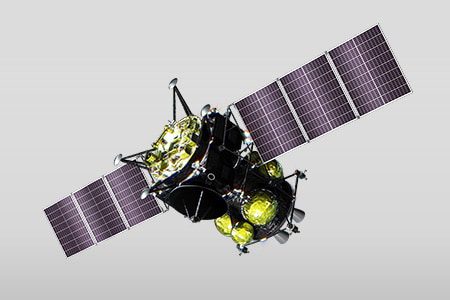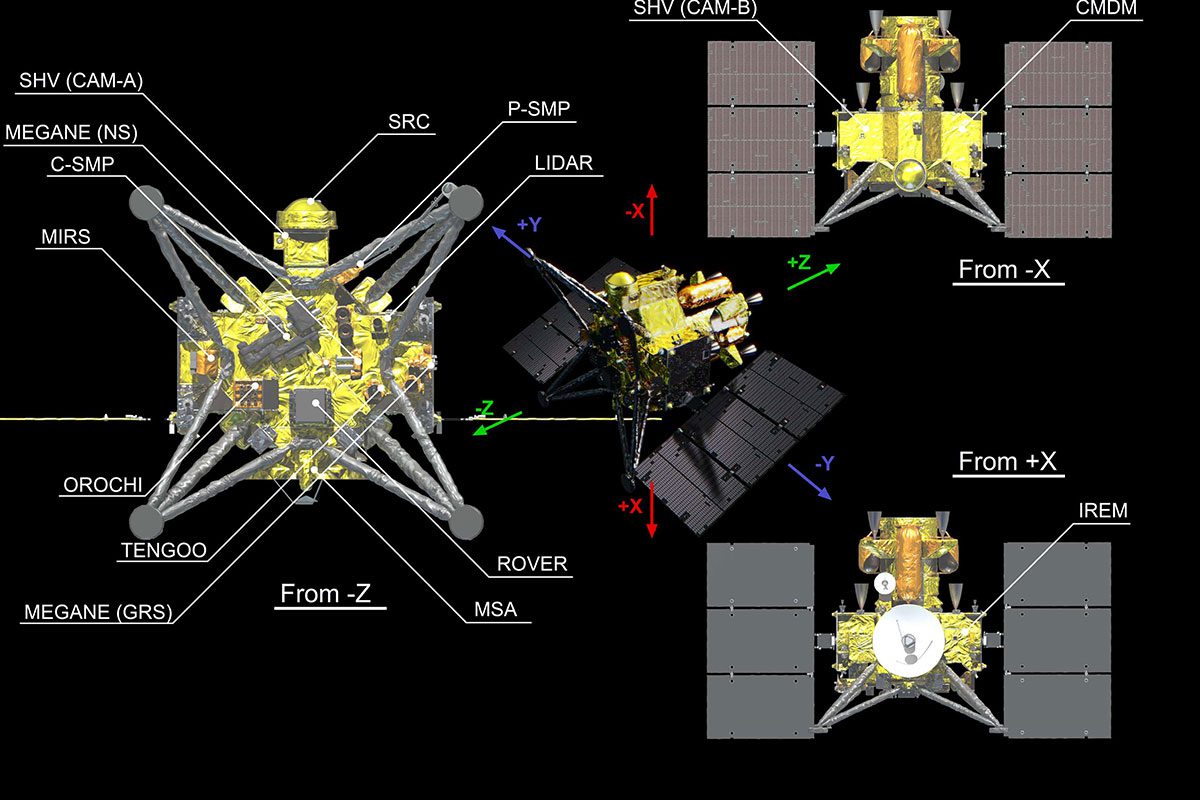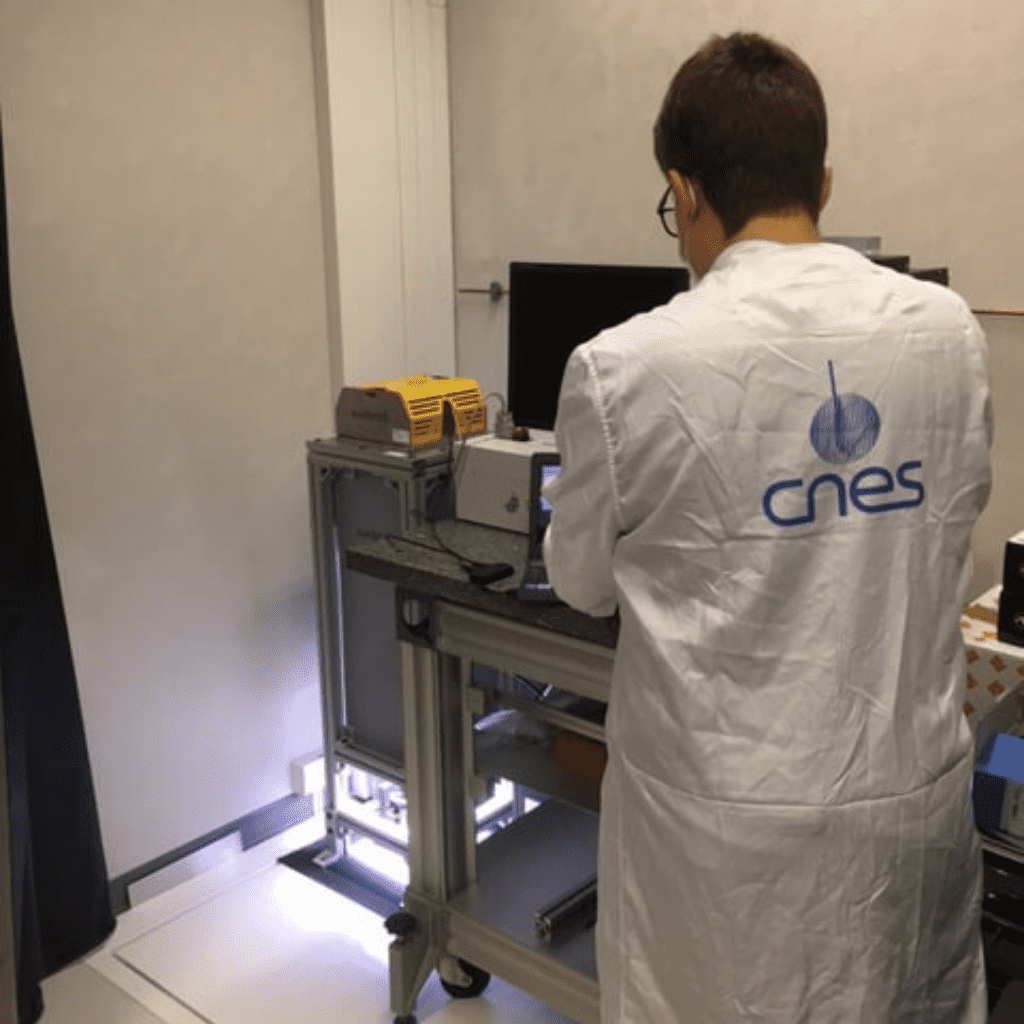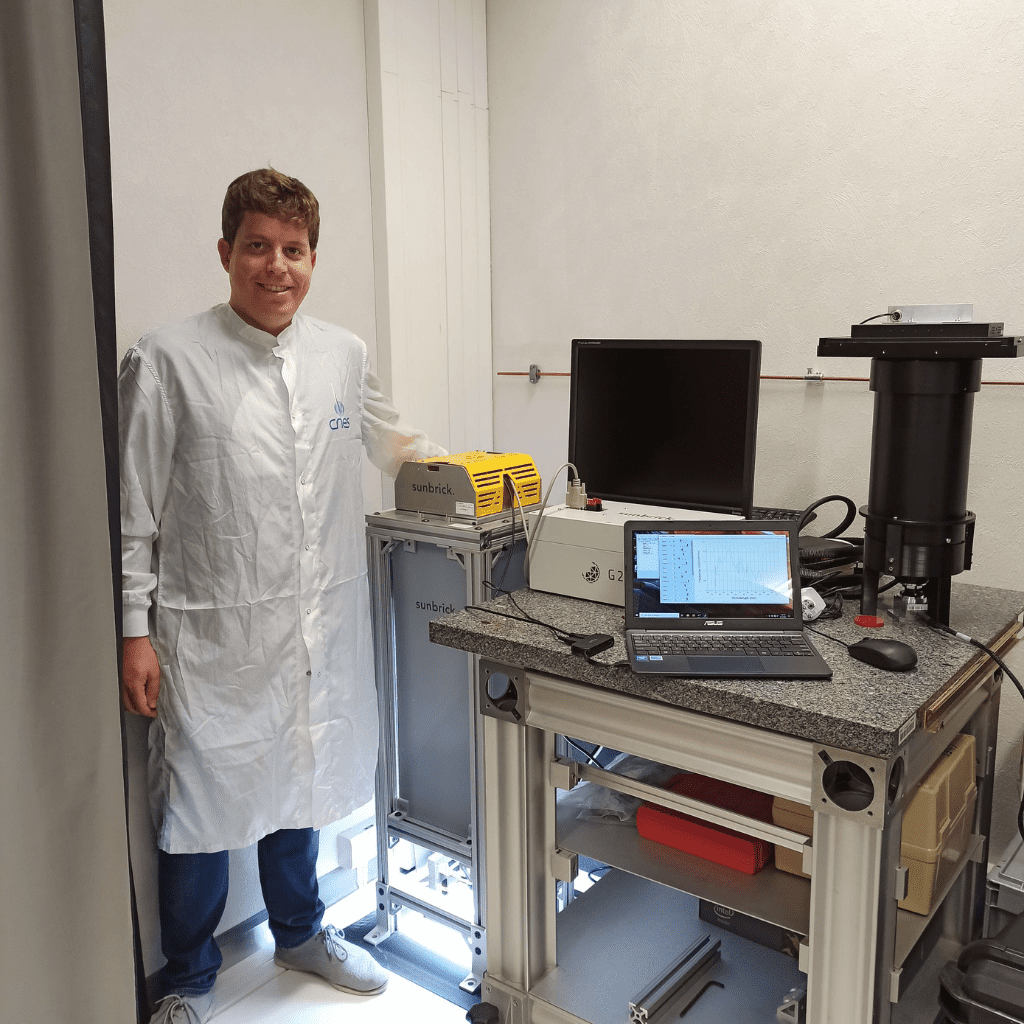G2V’s Sunbrick LED Class AAA solar simulator allowed attitude and control systems engineers at CNES to affordably do the high-quality, modular testing they needed in order to develop accurate sensors for the upcoming Martian Moons eXploration mission (MMX).
About the National Centre for Space Studies/le Centre Nationale d’études Spatiales (CNES)
As humanity ventures more often into outer space, we need to navigate safely and accurately, as well as maintain accurate surveillance over the increasing amount of orbital debris so we can get to space safely.
France’s Space Agency CNES (le Centre nationale d’études spatiales) has been focusing its recent efforts on these aspects of humanity’s space ventures, as well as on preserving Europe’s independent space launch capability.
CNES is a government agency that shapes and implements France’s space policy. It is committed to being socially responsible, making space protective and sustainable, creating shared value from space, reducing humanity’s eco-footprint, and supporting regional resilience.
CNES engages in projects with high business potential and applications for daily life. The Connect by CNES programme provides access to space data and technology expertise for French Tech innovators in order to lower the barrier of entry to the aerospace sector. In addition to all this, CNES serves as a technical field centre from which centralized initiatives can take place.
CNES will celebrate its 60th anniversary in December 2021, and it has done a lot in those six decades. For Yann Charront, an equipment engineer in CNES’s Attitude and Orbital Control Systems (AOCS) division, the agency allows him the opportunity to be part of an exciting blend of exploring the unknown while transforming those discoveries into tangible benefit on Earth.
“What G2V Optics offers is a more compact system — cheaper equipment that can be used for different projects with modularity built-in.” – Yann Charront, AOCS Equipment Engineer
The Challenges CNES Were Facing
CNES is currently involved in a wide variety of collaborative projects, one of which is the upcoming 2024 Martian Moons eXploration (MMX) mission.
The MMX mission plans to land a rover on Phobos, as well as execute a flyby of Deimos — both moons of Mars — before bringing home soil samples. These maneuvers will require, among other things, an accurate navigation and course correction system.

The MMX mission needs a robust Attitude and Orbital Control Systems (AOCS) in order for the probe and rover to maintain accurate positioning and trajectories.
Accurate Attitude and Orbital Control Through Light Detection
Tracking orientation in space is challenging, to say the least. When there is no up or down, you need to rely on other cues for a common reference. Stars are common points of reference in AOCS systems because they are roughly fixed in relation to us. Therefore, light sensors comprise one of the many types of navigational systems used in aerospace AOCS, and star trackers are quite commonly used.
Detecting small changes to the characteristics of incoming light is paramount for these instruments, since small angular errors correspond to huge distances when working at the orbital scale.
The AOCS systems are the eyes and ears of a satellite or spacecraft, and they have to be highly accurate and reliable.

AOCS systems developed at CNES aren’t restricted to the MMX mission. Many of their other projects require the same robust systems, including the Space Surveillance Tracking (SST) mission, which is part of a coordinated effort to track the several hundred thousand chunks of orbital debris in low Earth orbit so that launching into orbit and beyond can remain safe for generations to come.
Detecting small changes to the characteristics of incoming light is paramount for these instruments, since small angular errors correspond to huge distances when working at the orbital scale.
Accurate and Representative Ground Testing for AM0 Light Conditions
Yann Charront was working with his team on photodiode-based sun and star trackers that quantify the sun’s position and a spacecraft’s orientation. He needed some way of testing his photodiodes that didn’t require travelling outside Earth’s atmosphere. In other words, he needed the tools to carry out accurate ground testing. For any aerospace system, extra precautions are taken during testing in order to ensure results are representative of how a device will actually behave in its intended environment.
“We always want to be sure of what we’re doing. We take extra precautions so our results are not questionable.”
Ground testing is an important part in the development of any aerospace subsystem. Accurate simulation and testing environments here on Earth are key to minimizing both the costs and risks of launching equipment to any altitude, nevermind thousands of kilometers into inhospitable vacuum.
“We really need to have a good idea of a device’s performance, and we cannot do this without proper ground equipment. Because once you’re on Phobos — it took maybe two years to arrive — if you find you can’t charge your battery, you’re done.”
Accurate Flux and AM0 Spectra
The sun’s spectrum is different in space than it is on Earth, due to the absence of atmospheric absorption (where there is no air, or “air mass = 0” (AM0)). The differences are in total flux as well as spectral distribution. Therefore, Yann and his AOCS team needed a solar simulator that could reproduce the spectrum in space (AM0) with high fidelity and spectral match.
“For sun sensors, we need to have the flux the sensor is going to experience in orbit.”
This accurate spectrum and flux reproduction all tie into the requirements for accurate ground testing. Yann and his team needed to have a high level of confidence that their test results accurately represented a device’s expected behaviour in space, and that they’d adequately addressed possible risks of failure. Before reaching out to G2V Optics, Yann and his team had no ability to properly simulate the sun’s spectrum for testing and development.
“If you don’t have a Class AAA source, you measure a lot of noise, and you may have some bias or flickering. You cannot calculate anything related to performance without a good [solar simulator].”
Modular, Flexible Solar Simulation
Many more aerospace subsystems and materials need to be tested under sunlight as part of their vetting prior to implementation. While Yann and his AOCS team at CNES had access to a vacuum chamber in which they could carry out thermal testing, they wanted the flexibility of a modular system that could move to various locations for more localized testing within the agency. Yann wanted to expand his team’s capabilities with a more compact, portable solution.
High-Quality, Affordable Class AAA Solar Simulator
Yann’s budget would not allow him to purchase a solar simulator as expensive as their vacuum chamber, however. While he wanted a more affordable system, he also couldn’t compromise on spectral quality, because any inaccuracies in the spectra would reflect in his AOCS system’s ultimate performance. He wanted to be confident that any results he obtained could be attributed to the sensor’s performance, and that he wouldn’t have to spend long hours trying to parse whether anomalous behaviour was due to the light source or the detector.
“We had no means to do such testing before. It was totally uncharted territory.”
Angular Adjustments
One of the key parameters Yann needed to characterize for his photodiodes was their response to incoming light of different angles, because that would be central to determining a spacecraft’s orientation in relation to a light source. Therefore, any solar simulator solution would need to be configurable to irradiate samples at different angles.
“The first results were very encouraging. The Sunbrick cannot be called into question; its flux is steady and low-noise.” – Yann Charront, AOCS Equipment Engineer
LED-based Class AAA Solar Simulator Solution
Finding the Sunbrick: G2V Optics Solar Simulator Solution
Yann’s online search for solutions led him to G2V Optics, where he found clean and clear information on the Sunbrick Class AAA LED solar simulator. The Sunbrick offered all the aspects Yann was looking for, while being particularly unique in not requiring a massive setup like most of the other solutions he found.
A Large Area Solar Simulator and The Benefits of a Flexible Design
The Sunbrick met Yann’s criteria for compactness. It was an instrument he could move easily from his lab into or out of the clean room, all while retaining a large illumination area of 625 cm2 (25 cm x 25 cm).
Sunbrick’s Variable Spectra Allows Tuning LED Channels
The Sunbrick’s Variable Spectra Module allowed for the reproduction of the sun’s spectrum in outer space (AM0). The Sunbrick also had the benefit of being software-controlled, meaning Yann could load his spectrum and get up and running with a few mouse clicks.
The Variable Spectra Module also provides the ability to individually tune LED channels, allowing Yann to adjust narrow wavelength bands of interest in order to probe his device’s sensitivity under different illumination. This type of flexibility is simply not possible with a xenon or metal-halide bulb-based simulator.
G2V Optics: An Affordable Class AAA Solar Simulator
All of the Sunbrick’s features came at a reasonable price, allowing Yann to greatly increase his experimental capabilities while staying within budget, all without compromising on solar simulator quality.


Sunbrick’s Ease-of-Use and Rapid Setup
Yann’s favourite thing about the Sunbrick is its ease of use. The installation was straightforward and the user interface was intuitive, with clear sliders and controls he navigated seamlessly.
“The Sunbrick is very fast to set up, and the GUI is clear and easy.”
“Would I recommend G2V to others? Yes – I already have.” – Yann Charront, AOCS Equipment Engineer
The Results CNES Unlocked with Class AAA Light
The first test Yann did with the Sunbrick was to put a sensor in at 0 degrees angle of incidence (AOI). He then mounted his sensor on a gyro table to tilt its angle relative to the Sunbrick, which turned out to be the more reasonable solution because of the small relative size of his sensors.
Now he’s got a 3D printed setup that allows tilting in two axes, and that he’s programming to be able to do a fully-automated scan of the Sunbrick’s sky. Such rapid automated testing is going to empower him to make quick insights and advances in the development of his team’s sun tracker.
Armed with G2V’s Python API and LabView API, Yann’s team is also positioned to increase the level of automation in his testing environment.
First Insights From a Tunable LED Solar Simulator
With the Sunbrick, Yann has been able to compare two different sensor measurements: those when connected to the MMX rover’s onboard computer, and those obtained from an EGSE (electrical ground support equipment) manufacturer. The EGSE system is designed to provide highly reliable, high-performance equipment for initial testing, but this equipment is not designed to be sent into space. In this test, Yann wanted to evaluate any sources of noise and bias, as well as gain peace of mind that the solar simulator could be trusted. One of his overall project goals was to quantify the noise from the electronics, so the less noise from the solar simulator source, the better.
Sharing the Benefits of Class AAA Light
Yann was so pleased with the Sunbrick that he’s already recommended it and loaned it to another team within CNES that’s working on building and testing AM0 solar panels for the mission.
That team is doing lifetime testing for another satellite, where a solar panel is put into a vacuum chamber and the temperature cycled. Between each phase of cycling, they remove the solar panel, and then use the Sunbrick to ensure the panel’s performance has not degraded. This solar panel test is done roughly once a month for approximately four hours.
Improved Aerospace Testing Yields Longer Lasting Results
Yann’s test results and scans of the Sunbrick’s sky will allow him to prepare the MMX rover’s singular sun sensor for deployment on Phobos.
Exploring the moons of Mars will provide humanity with new knowledge and insights, but that will only happen with reliable, well-developed equipment.
With the Sunbrick, Yann is able to focus more time and attention on developing the crucial sensor. With an affordable Class AAA solar simulator system that’s easy to use, compact and modular, he and his colleagues are getting test results they can trust, ultimately developing technologies that will enable humanity to safely and more richly explore our universe.
References
CNES (2021). “Le site du centre national d’études spatiales.” Retrieved online on Sep 13, 2021 from https://cnes.fr/en
CNES (2020). “MMX (Martian Moons Exploration).” Retrieved online on Sep 13, 2021 from https://mmx.cnes.fr/en/mmx-martian-moons-exploration-0
JAXA (2016). “Configuration diagram of the mission instruments onboard the Martian moons eXploration (MMX) (black background).” JAXA Digital Archives. Retrieved online on Sep 13, 2021 from http://jda.jaxa.jp/result.php?lang=e&id=e38ead3903eb9982cf274811036e4510
JAXA (2015). “Gallery: MMX – Martian Moons Exploration.” Retrieved online on Sep 13, 2021 from https://www.mmx.jaxa.jp/en/gallery/
Office for Science & Technology at the Embassy of France in the United States (Jan 13, 2021). “CNES in 2021 – An ambition serving citizens asserting our need for Space.” CNES – Actualites (EN). Retrieved online from https://france-science.com/en/cnes-in-2021-an-ambition-serving-citizens-asserting-our-need-for-space/#
Travis, Henry (2020). “Introduction to Satellite Attitude Control.” in Advances in Spacecraft Attitude Control, edited by Sands, Timothy. Retrieved online on Sep 13, 2021 from https://www.intechopen.com/chapters/69603



